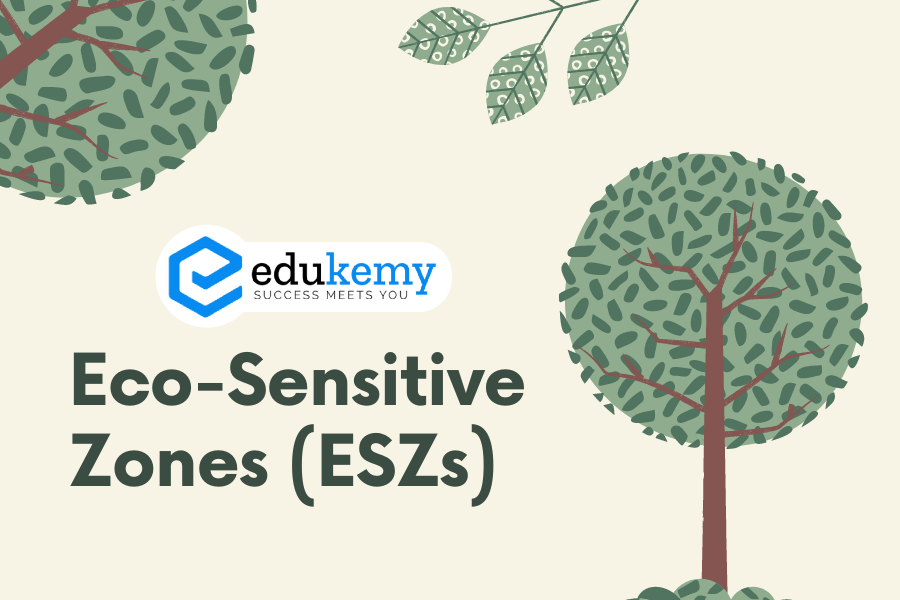- The National Wildlife Action Plan (2002-2016) issued by the Ministry of Environment, Forest and Climate Change (MoEFCC) mandated that state governments designate land within a 10 km radius of the boundaries of national parks and wildlife sanctuaries as eco-fragile zones or Eco-Sensitive Zones (ESZs) under the Environmental (Protection) Act, 1986.
- While the 10-km guideline serves as a general principle, the application of this rule may vary.
- Additionally, areas exceeding the 10 km limit can be officially designated as ESZs by the Union government, especially if they encompass larger ecologically significant “sensitive corridors.”
Contents
- 1 FAQs – Eco-Sensitive Zones (ESZs)
- 1.1 1. What is the mandate for designating Eco-Sensitive Zones (ESZs) in India?
- 1.2 2. Does the 10 km guideline for ESZs have variations in its application?
- 1.3 3. What are the prohibited activities within Eco-Sensitive Zones?
- 1.4 4. What activities are regulated within ESZs?
- 1.5 5. What activities are permitted within Eco-Sensitive Zones?
- 2 In case you still have your doubts, contact us on 9811333901.
ACTIVITIES AROUND ESZ
- Prohibited Activities: Activities such as commercial mining, operation of sawmills, industries causing pollution (air, water, soil, noise, etc.), establishment of major hydroelectric projects (HEP), and commercial use of wood are strictly prohibited.
- Regulated Activities: Certain activities, including the felling of trees, establishment of hotels and resorts, commercial use of natural water, erection of electrical cables, and drastic changes in agriculture systems (e.g., adoption of heavy technology, pesticides, etc.), are subject to regulations.
- Permitted Activities: Ongoing agricultural or horticultural practices, rainwater harvesting, organic farming, use of renewable energy sources, and the adoption of green technology for all activities are permitted within Eco-Sensitive Zones (ESZs).
SIGNIFICANCE OF ESZ
- Minimizing the Impact of Development Activities:
- Eco-Sensitive Zones (ESZs) play a crucial role in minimizing the impact of urbanization and other developmental activities, particularly in areas adjacent to protected areas.
- In-situ Conservation:
- ESZs contribute to in-situ conservation, focusing on preserving endangered species in their natural habitats. An example is the conservation of the One-horned Rhino in Kaziranga National Park, Assam.
- Reducing Forest Depletion and Man-Animal Conflict:
- By minimizing forest depletion and mitigating man-animal conflicts, ESZs contribute to the sustainable management of protected areas. The core and buffer model of management protects and benefits local communities.
- Preserving Fragile Ecosystems:
- Eco-Sensitive Zones are designated to minimize the negative impact on fragile ecosystems. They act as a protective buffer, serving as a ‘Shock Absorber’ for the adjoining protected areas.
- Transition Zones for Varied Protection Levels:
- ESZs act as transition zones, providing a gradual shift from areas with high protection to those with lesser protection. This ensures a balanced approach to conservation across different zones.
CHALLENGES ASSOCIATED WITH ESZ
Climate Change Impact:
- Climate change poses significant challenges to Eco-Sensitive Zones (ESZs), leading to increased stress on land, water, and ecological systems.
- Instances such as frequent forest fires and the Assam floods adversely affect protected areas like Kaziranga National Park and its wildlife.
Encroachment on Forest Rights:
- The implementation of The Environmental Protection Act, 1986, and the Wildlife Protection Act, 1972, can sometimes lead authorities to overlook the rights of forest communities, impacting their lives and livelihoods.
- This challenge includes the potential dilution of rights granted to gram sabhas for developmental clearances.
Recognition of Forest Rights and Gram Sabha Consent:
- The recognition of forest rights and the requirement for gram sabha’s consent were prerequisites for evaluating proposals under The Forest Rights Act, 2006, to divert forest land for non-forestry purposes.
- However, these conditions were done away with by the Ministry of Environment, Forest and Climate Change (MoEFCC) in 2022, raising concerns about the protection of community rights.
FAQs – Eco-Sensitive Zones (ESZs)
1. What is the mandate for designating Eco-Sensitive Zones (ESZs) in India?
A: The National Wildlife Action Plan (2002-2016) issued by the Ministry of Environment, Forest and Climate Change (MoEFCC) mandates state governments to declare areas within a 10 km radius of national parks and wildlife sanctuaries as Eco-Sensitive Zones under the Environmental (Protection) Act, 1986.
2. Does the 10 km guideline for ESZs have variations in its application?
A: Yes, while the 10 km guideline serves as a general principle, the application of this rule may vary. Additionally, areas beyond the 10 km limit can be designated as ESZs by the Union government, especially if they encompass larger ecologically significant “sensitive corridors.”
3. What are the prohibited activities within Eco-Sensitive Zones?
A: Prohibited activities include commercial mining, operation of sawmills, industries causing pollution (air, water, soil, noise, etc.), establishment of major hydroelectric projects (HEP), and commercial use of wood.
4. What activities are regulated within ESZs?
A: Regulated activities within ESZs include the felling of trees, establishment of hotels and resorts, commercial use of natural water, erection of electrical cables, and drastic changes in agriculture systems (e.g., adoption of heavy technology, pesticides, etc.).
5. What activities are permitted within Eco-Sensitive Zones?
A: Permitted activities include ongoing agricultural or horticultural practices, rainwater harvesting, organic farming, use of renewable energy sources, and the adoption of green technology for all activities.
In case you still have your doubts, contact us on 9811333901.
For UPSC Prelims Resources, Click here
For Daily Updates and Study Material:
Join our Telegram Channel – Edukemy for IAS
- 1. Learn through Videos – here
- 2. Be Exam Ready by Practicing Daily MCQs – here
- 3. Daily Newsletter – Get all your Current Affairs Covered – here
- 4. Mains Answer Writing Practice – here

